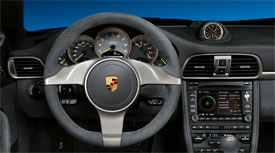2010 Porsche 911 GT3
Back in the late 90s, Porsche set out to make its 996 generation 911 sports car into a bonafide track machine. From that effort emerged the highly revered GT3. In 2006, the GT3 showed up on the latest 997 platform. We said that car delivered the purest razor’s-edge performance of any Porsche we’d driven. Now for 2010, Porsche’s 911 GT3 gets tweaked with more power and a number of corner carving enhancements, all of which make for a racing bloodline that runs stronger than ever.
The ‘wow’ factors of the 2010 Porsche 911 GT3 arrive on all fronts: power, dynamics, and visual cues. As the entire 911 family has just undergone a notable set of revisions, the GT3 got more than its fair share. And since this car is, after all, the road-going variant to Porsche’s GT3 Cup car, bringing it to our winter testing venue, Georgia’s Roebling Road raceway, was a no-brainer.
The new GT3 starts with an expanded 3.8-liter normally aspirated flat-six, now with Variocam technology on both the intake and exhaust valves. Horsepower goes to 435, or 20 more than before, while torque bumps up from 300 to 317. Redline also edges up to a robust 8500.
On its way to a top speed of 194 miles per hour, the rear-engine, rear drive GT3 rockets from 0-to-60 in a faster-than-fast 4.1 seconds. We clocked the quarter mile in 12.2 seconds at 118 miles per hour.
 With a six-speed manual feeding a limited slip differential, this car just hooks up and goes. Power build is strong and the throttle pedal is extremely responsive. Adding to the exhilaration is an exhaust note that is mean and aggressive, at least for a Porsche. Gears are tightly-spaced and the shifter feels machine-precise… one of the best we've ever experienced.
With a six-speed manual feeding a limited slip differential, this car just hooks up and goes. Power build is strong and the throttle pedal is extremely responsive. Adding to the exhilaration is an exhaust note that is mean and aggressive, at least for a Porsche. Gears are tightly-spaced and the shifter feels machine-precise… one of the best we've ever experienced.
As for hitting the turns, the new GT3 exhibits more agility and race track prowess than ever. Porsche Active Suspension Management – with Normal and Sport modes – comes armed with stiffer springs and anti-roll bars. Our car also featured optional Dynamic Engine Mounts, which magnetically tighten up in high-speed driving to form a more solid connection between engine and chassis. The result is a more rigid track car.
There's also newly standard Porsche Stability Management, which replicates the suspension mapping of the venerable GT2. This PSM has the ability to deactivate Stability Control and Traction control separately in individual steps, giving the driver unrestricted control.
Aerodynamics improvements include a doubling of downforce with a redesigned front-end with larger vents, and a new, wider, more steeply tilted rear wing. For even greater stability, the GT3's body height has been lowered by about 30 millimeters. But an optional front axle lifting system allows the front-end to be raised for steep driveways. Lighter 19-inch center-lock wheels wear fat and grippy 235/35s up front, and 305/30s in the rear.
The GT3 is clearly focused on one mission: to deliver outstanding lap times. It is super tight in corners and explosive on every exit, with less twitchiness than we found in the 2007 GT3. Feedback is instantaneous. And even after close to a hundred and fifty laps, our test car never complained, skipped a beat, or even showed signs of wear.
That goes for brakes, too, which have been upgraded over the previous model. Discs are now larger, better ventilated, with an aluminum hub to reduce weight. Stops averaged 121 feet from 60 to zero. For even greater stopping power, buyers can opt for the GT3's very pricey ceramic brakes. Off the track, however, we found the GT3 to be a little too skittish and rigid. Streetability is not—and has never been—this car's strong suit.
 The GT3's new design is equal parts functional and striking. We mentioned the modified front air intakes and the revamped rear wing, which by the way, is marked on either side with a 3.8 to denote the car's new power unit.
The GT3's new design is equal parts functional and striking. We mentioned the modified front air intakes and the revamped rear wing, which by the way, is marked on either side with a 3.8 to denote the car's new power unit.
The new GT3 also wears standard bi-xenon headlights with optional Dynamic Cornering, new LED running, and taillight designs, and restyled bumpers. As before, the center-positioned exhaust pipes mimic those of the Cup Car.
Inside, the GT3 cockpit conforms with the upscale high-performance look of other 911s. As before, there is no back seat. This helps the GT3 retain its previous weight at a trim 3,076 pounds.
What's higher, though, is the base price—by about $8,000. The new GT3 starts at $114,450, which includes a $1,300 gas guzzler tax. We've said it before and we'll say it again… The Porsche 911 GT3 is, without a doubt, one of the track-savviest street legal cars anywhere. And now more than ever. For the purest form of Porsche performance, there is nothing else like it.
Specifications
- Engine: 3.8-Liter Normally Aspirated Flat-six
- Horsepower: 435
- Torque: 317 Lb Feet
- 0-60 MPH: 4.1 Seconds
- 1/4 Mile: 12.2 Seconds @ 118 MPH
- 60-0 MPH: 121 Feet
2025 Volkswagen ID. Buzz
Volkswagen Brings Beetlemania Level Of Excitement To Minivan Segment
The duty of upholding Volkswagen’s heritage has most recently been delegated to small legacy car names like Golf and Jetta. But hold on! A much larger, totally modern take on VW’s classic microbus has just buzzed over the horizon— the all-electric ID. Buzz. It’s been at the top of our minds since we first saw the concept back in 2017. Well, it’s finally here, so let’s get our groove into drive!
This 2025 Volkswagen ID. Buzz has indeed created the most buzz around Volkswagen since the Beetle’s return to the U.S. in the late 1990s. We couldn’t drive it anywhere without drawing a crowd. No wonder, just about everyone has a VW Microbus story to tell, and seeing this reimagined version rolling down the street brings back all those memories.
VW really pulled it off as far as we’re concerned, as it looks great without appearing over the top. All the cues are here: Big VW logo front and center, lots of greenhouse including A-pillar windows and mini sliders for the second-row passengers, D-pillar air vents, and two-tone wheels. And while its appearance may be pure retro, its drivetrain is far from it, as the ID. Buzz is all-electric, and unlike the new Beetle, the Buzz does retain the original Microbus’ rear-drive architecture.
Powering those rear wheels is a 210-kW motor drawing juice from a 91-kWh battery for a range of 234 miles; 200-kW max charging will get you to 80% in about 26 minutes. Buyers can add another small 80-kW motor up front for 4motion all-wheel-drive and an increase of total output from 282 to 335 horsepower with a combined 512 lb-ft of torque. It uses the same battery, but range estimates drop just slightly to 231 miles. But while those numbers are modest, we also found them to be quite conservative, as we observed as many as 287 miles available in our all-wheel-drive tester’s gauge display and were on pace for 273 miles in our driving loop.
One throwback theme that may be a turnoff to some is that it’s quite a step up into the Buzz’s front seats, but there’s certainly a commanding view of the road once you climb in. Second row seating can be either a three-place bench or a pair of captain’s chairs, so there’s generous room for seven or six passengers. The captain’s chairs in our Pro S Plus offer good support and very easy access to the third row.
Lots of flexibility too with the option to simply fold the seats or remove them altogether.
With the sliding side doors and a wide opening rear hatch, there’s plenty of access for loading big sport utility amounts of cargo. Lots of flexibility too with the option to simply fold the seats or remove them altogether, and the ability to create a full-length flat floor with a rear cargo shelf that covers some handy removable storage bins. There’s 18.6 cubic-feet of space behind the third row, 75.5 behind the second, and a max of 145.5. That’s more than a Chevrolet Tahoe. For smaller items, there are lots of cubbies throughout the cabin, along with a standard Buzz Box that can be moved to multiple locations.
With a design that prioritizes retro form and modern function over aero efficiency, the 4motion equipped ID. Buzz earns a Fair efficiency rating, using 42-kWh of electricity per 100 miles, and we weren’t sure what to expect at our Mason Dixon test track.
What we found was great torque off the line and drama free launches to 60 in just 5.3 seconds. It was very stable at speed and power delivery stayed steady most of the way down the track until we reached about 90 mph, when it began to taper off just before we finished the quarter-mile in 14.0 seconds flat at 97 mph.
With 1,200-lbs. of battery weight nestled in its 127.5-inch wheelbase, the Buzz felt planted to the pavement through our handling course. There was quite a bit of body roll to deal with, but surprisingly little understeer. In panic braking runs, pedal response was inconsistent, feeling soft at times, pushing back hard at others; but through it all, results were quite good, stopping from 60 in an average of just 108 feet.
Three interior themes are available, this Dune is the brightest, featuring coastal inspired wood optic dash décor, “gray and clay” leatherette surfaces, and a high-mounted central 12.9-inch touchscreen. Pricing starts with a rear-wheel-drive Pro S at $61,545; this Pro S Plus begins at $65,045, add another $4,500 for 4motion, which brings a few extra features along with all-wheel drive.
Retro design with old-school VW charm, modern EV drivetrain, big SUV capacity merged with minivan flexibility; it all comes together in this 2025 Volkswagen ID. Buzz. It’s easily one of the coolest rides of the year and one that will likely keep Volkswagen dealers buzzing for years to come, and that’s something no other people and things mover can say.
Specifications
As Tested
- Motor Setup: Dual-Motor AWD
- Battery Size: 91-kWh
- Horsepower: 335
- Torque: 512 lb-ft
- EPA Range: 231 miles
- 0-60 mph: 5.3 seconds
- 1/4 Mile: 14.0 seconds at 97 mph
- Braking, 60-0: 108 feet
- MW Test Loop: ~ 273 miles













































